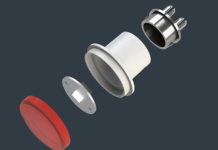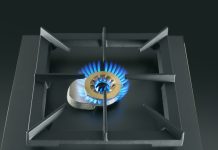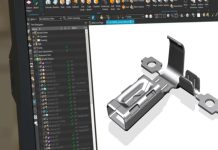Due to research and development activities, to the technologically advanced production and the proposal of connected products able to improve people’s life quality, Okida confirms to be one of the realities most awarded by the market.
by Massimiliano Luce
Precisely as it happened before the pandemic, the market goes on awarding Okida. Sabaf Group’s company, in fact, says goodbye to 2021, filing a year of noteworthy results. «We are extremely satisfied», confirms Michele Squicciarini, Okida R&D director. «Initially, we feared the pandemic would negatively affect results whereas, fortunately, our sector ranked among the few not damaged by this unlucky situation. In addition to that, we have accomplished various designs started in pre-pandemic phase and, at the same time, the market has awarded us, acknowledging us innovation skills, quality and competitiveness».
The driving engine of Okida’s growth is represented, in particular, by research and development activities, defined by Squicciarini «the lifeblood for every company, preliminary requisite for innovation and, therefore, future». For this reason, Okida strongly focuses on it and facts prove it. «R&D team in Okida has exponentially grown in recent years, up to relying on over 30 engineers today», the R&D director adds. «The research allows us to carry out both product innovation, which can be demanded by the market or in-house driven, and innovation in terms of specifications and performance of the product itself. Finally, innovation can be also addressed to the reduction of manufacturing costs».

Fully automated production
Naturally, the target is turning ideas into reality, to full benefit of customers. «The development is the concretization of ideas coming from research», Squicciarini explains. «In this case, we can implement innovative products we have ideated or develop new solutions according to our customers’ wishes».
Precisely for this reason, the attention paid to nature and to the quality of production processes becomes decisive. «Okida has always been a company where the core of the manufacturing philosophy is the research and the use of the most advanced technologies», Squicciarini highlights. «Joining Sabaf Group, the investment capacity has further grown and has allowed us to upgrade, to improve and to extend the machine fleet equipping the company. All manufacturing processes are fully automated and the production control component is distributed along all line stages, to assure the utmost quality in each phase. Concerning this, it is worth mentioning: SPI (Solder Paste Inspection) allows assessing the correct positioning of the component on the electronic board with regard to the solder paste, a check process that is essential for the final product quality; AOI (Automatic Optical Inspection), the automated 3D optical inspection that verifies that all welding points at the end of the process itself have been perfectly executed; ICT (In-circuit testing), used to test automatically in-line all components and all nodes of the electrical circuit».
Moreover, today the innovation concept spontaneously recalls the paradigm of Industry 4.0, with which Okida proves they are acquainted. «Okida has adopted a MES (Manufacturing Execution System) that, actually, is used to detect all the information connected with the manufacturing cycle and to monitor, in real time, the production. Using real-time data, MES collects and transmits data concerning the activities of the factory and of manufacturing divisions, communicating with the corporate ERP to optimize processes of production, logistics and control of stocks and resources. Due to this system, for instance, the SPI control communicates the need of modifying the stage setting upstream or downstream, according to the deviations detected in real time on a stage in particular», Squicciarini underlines.
The strict relationship with innovation, on the other hand, can also reveal how critical the approvals for the various markets can be. Aspect the company proves to face smartly. «Okida has achieved for all of its products the necessary certifications for their marketing in the Countries demanded by our customers», Squicciarini points out. «ENEC and UL certifications are undoubtedly the most demanded. Okida is in contact with all certifying bodies and can assist its customers in case it is necessary to extend the certification to new products. Moreover, if customers want to certify autonomously Okida component assembled on the final product, we can support them in all certification phases».

New products, same user-friendliness
Concerning markets and customers, today there are some sectors considered by Okida with particular interest, ready to join the most conventional and consolidated ones for the company. «Okida was established as supplier of electronic components for the household cooking sector, in the specific case timers for electric and gas ovens», Squicciarini illustrates. «Along the years, we have notably enlarged our product range and today we can supply components that address, among the others, the sector of hoods, of small household appliances, of refrigerators and of liquid dispensers. Recently, we have also entered the medical sector and we are always pursuing and searching for new opportunities in the most different sectors».
Squicciarini highlights some products that are currently most interesting and searched by customers. «The most successful products, which are arousing more success and interest among our customers, include the controls for pyrolytic ovens. In the past, the pyrolytic function was reserved just to high-end and very high-end fully electronic ovens. We are instead witnessing the extension of this function also to average-range ovens, where controls are mixed: electromechanical function selectors joined by simplified electronic controls that include anyway advanced functions, such as the electronic thermostat control, the electronic control of door locks (mandatory for the pyrolytic function), the meat probe and the presence of auxiliary relays for the automated management of auxiliary functions such as ventilation, lights and so on».
It is a proposal characterized by some challenging specificities indeed. «Typically, in this product range a strong price competitiveness is required and therefore displays with LED technology are used, but our range also provides for displays with icons that identify the active functions of the oven, in order to allow a better user experience», Squicciarini points out.
The future astride IOT and sensors
Concerning the future of products, Okida has already selected some aspects and issues on which it is more focusing with its research and development activity. «Some applications, due to their intrinsic features, need the certification in the so-called B class, according to the IEC 60730 regulation», Squicciarini argues. «Therefore, the pursuit of utmost safety in utility requires, both on the European and on other markets, the need of radically changing the approach to the product development. This means designing both the hardware, but especially the software, so that in case of unexpected failure the product enters a foreseeable operation status, already determined in design phase. It is clear that this type of approach implies the adoption of design techniques such as FMEA, even more targeted to the so-called “fault component analysis”. Besides, the regulation demands that the validation of the software used occurs in all development phases. In order to guarantee the traceability of the software itself, advanced “version control” tools are used and they allow both the development team and the certifying body to identify punctually the various successive versions of the released software».
Concerning the offer, other novelties will spring from the enhancement of people’s connection and wellbeing concept. «Currently, among the various functions at which we are working and deemed very interesting by the market, we find IOT and sensors for the air quality at home. The IOT function allows us to devise endless new applications and interactions of our electronic controls, one another and with the domestic eco-system, meant as the whole of household appliances, smartphones and devices like Alexa or Google Home. The growing attention paid to the quality of the air in houses», Squicciarini ends, «has led us to implement controls equipped with sensors that, precisely perceiving the air quality level contained in a given environment, automatically operate the filtering functions of a hood, of a hob or any other appliance intended for the air filtering».



